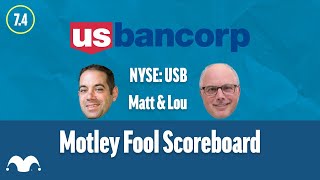
There are a handful of executives that avid bank stock investors should follow closely; US Bancorp's (USB +0.83%) Richard Davis is one of them. For readers fond of sports analogies, he's the Aaron Rodgers of banking -- an exceptional, but understated, executive of a perennial industry leader.
At a recent conference, Davis shared his views on US Bancorp and the financial industry more generally. Here are the three main things that investors can take away from his presentation:
1. Putting US Bancorp in perspective
US Bancorp occupies a unique position in the bank industry. While there's no question that it's a very big bank, it nevertheless pales in comparison to its four too-big-to-fail peers, as you can see in the slideshow below. By the same token, however, it towers over most other regional lenders, with $419 billion in assets on its balance sheet.
When trying to put US Bancorp in perspective, in turn, the easiest way to do so is to think of it as America's biggest regional bank. But Davis offered a more precise designation. As he explained:
[I]n terms of size and scale, we're the largest non-G-SIFI bank in America. That's a new designation I call us. We're just a small little bank from Bloomington, Minnesota, don't you know. But this company has grown to be a really perfect sweet spot at $400 billion. We've got a really good breadth and depth and also have this ability to stay under the radar screen in terms of some of those G-SIFI too-big-to-fail issues that some of our brothers have to deal with.
By "G-SIFI," Davis is referring to the biggest banks in the world, which are subject to stricter regulatory oversight and higher capital requirements than their smaller rivals. Sidestepping these gives the "small bank from Bloomington, Minnesota," a competitive advantage over bigger banks, while also allowing it to exploit the economies of scale associated with being the nation's largest regional lender.
2. Insight into expenses
If you're looking for one thing that makes US Bancorp standout from the pack, it's the bank's efficiency ratio -- that is, the percent of net revenue consumed by operating expenses. Most big banks strive for an efficiency ratio under 60%, but few achieve this over all stages of the credit cycle. US Bancorp is an exception. In fact, its efficiency ratio is typically closer to 50%.
This is important for multiple reasons. It allows a larger share of its revenue to fall to the bottom line, boosting net income and earnings per share. This in turn helps US Bancorp maintain its generous and dependable dividend and share buyback strategies -- between the two, it distributes 76% of its net income. And it allows US Bancorp to compete for the highest quality borrowers by undercutting the loan terms offered by its competitors without jeopardizing its industry-leading profitability metrics. This translates into lower loan losses over time, compounding it's already stellar return on equity.

Over the last few years, however, US Bancorp's efficiency ratio has headed in the wrong direction. Given this, Davis wanted to set the record straight by letting shareholders know that the bank is working to remedy this:
[S]tarting with February of last year . . . we put an FTE hold in place at the company. That's not a hiring freeze. An FTE hold is such that if you're a line of business manager, you have 964 employees, you can have 964. You can't have 967, but you can have 964. And so if somebody leaves, you can replace them. As we went further, we started to upgrade the talent into this year and said since we're going to keep this hold in place, it'd be great if you would understand that the 964 are not all equal, and I would like to encourage you to separate some of the low performers, move them out of the company and replace them with higher quality people, if you hadn't already.
3. Why debt ratings matter
Last but not least (to read the entire transcript of Davis' presentation, click here), Davis expounded on the importance of US Bancorp's stellar debt rating, which is among the best in the industry.
A bank's debt rating matters because it dictates its cost of funds. Just like you and me, a bank with a low rating must pay more to borrow money than a bank with a high rating. But unlike you and me, this is particularly critical for banks, as their entire business model is predicated on the ability to borrow funds at low interest rates which are then reinvested into higher-yielding loans and securities. If Bank of America's debt rating was as high as Wells Fargo's, for instance, the former would save somewhere along the lines of $2 billion a year in interest expense.
Davis teased out these advantages by explaining that US Bancorp's "best-in-class" debt ratings:
allow us to benefit from pricing. And again, this is an audience that understands this, but if we're going to the markets and we can receive 5-year money at a 40 to 60 basis point benefit from our peer group, that's 5 years we get to price things better by 40% to 60% -- basis points and/or at least take half of it and put it into price. We only deal with high-quality customers, so we're not using it for subprime or near-prime purposes. We're using it for the best customers to win them and keep them, but we're unabashed about saying that we'll use pricing as a tool at this moment in time.
In sum, if you've ever wondered how US Bancorp has been able to separate itself from the pack, the three points discussed here should go a long way toward clearing that up.






